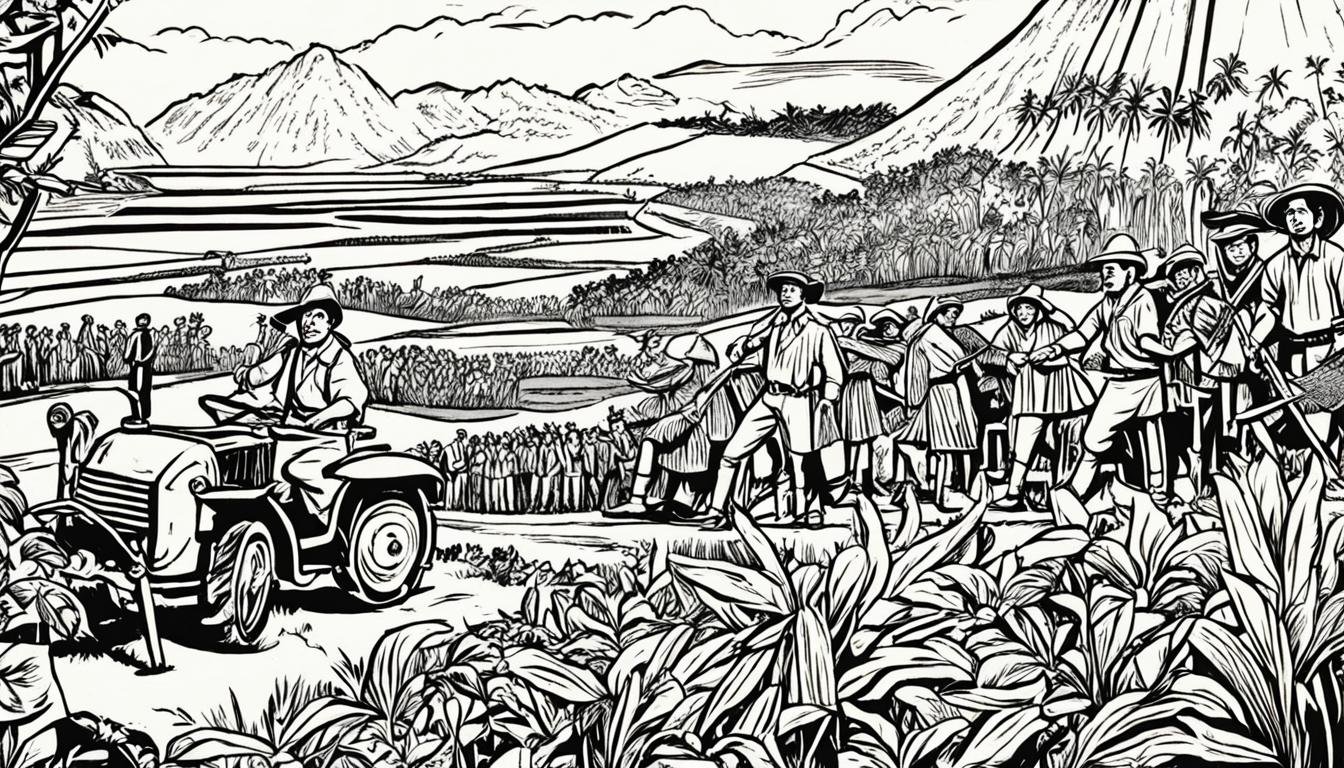Just over two years, the First Philippine Republic met many social challenges. It started in 1899 during the fight against Spain and the Philippine-American War. This new republic faced problems with class differences, not enough schools for everyone, and poverty. It also dealt with health issues, unequal treatment of men and women, and attacks from the war.
The leaders at the Malolos Congress made a constitution that aimed to solve these problems. But this republic only lasted until 1901. Then, its first president, Emilio Aguinaldo, chose to support the United States. Because of this choice, the changes the Malolos Congress wanted were cut short.
Key Takeaways
- The First Philippine Republic, also known as the Malolos Republic, faced significant social issues during its brief existence from 1899 to 1901.
- These issues included class inequality, lack of universal education, poverty, healthcare challenges, gender inequality, and political instability.
- The Malolos Congress, which drafted the constitution, grappled with these social concerns, but the republic’s short lifespan hindered the implementation of meaningful reforms.
- The First Philippine Republic’s experience highlights the challenges of nation-building and addressing deep-rooted societal problems in a newly formed government.
- Understanding the social issues faced by the First Philippine Republic provides valuable insights into the ongoing social challenges in the Philippines today.
Introduction to the First Philippine Republic
The First Philippine Republic, also known as the Malolos Republic, was set up in 1899. This came after the successful Philippine Revolution. This was against Spanish rule followed by the Spanish-American War. It was Asia’s first constitutional republic even though there were older republics in Asia. The Malolos Republic started in Malolos, Bulacan. Emilio Aguinaldo became its first president. This republic governed until 1901, when Aguinaldo chose to support the United States, which ended the Malolos Republic.
The Philippine Revolution and the Spanish-American War led to the formation of the First Philippine Republic. Aguinaldo, who played a vital role, was elected its first president. This republic aimed to establish a free and democratic nation.
Even though the Malolos Republic existed shortly, it was key in the Philippines’ path to self-rule and freedom. It was Asia’s first republic with a constitution. This showed the nation’s goals for a government by the people and the separation of government and religion.
Class Inequality and Elitism
The First Philippine Republic faced big challenges with class inequality and elitism. In this time, the ruling class was mainly the wealthy and educated. The rest of the people, the common folk, lived very differently. This elite group had most of the power and wealth. Meanwhile, most people battled poverty and lacked chances to do better.
Because the power and wealth were so unbalanced, many were not happy. It was hard to form a government that truly spoke for everyone.
Disparity Between the Ruling Class and Masses
The gap between the rich and the poor was huge in the First Philippine Republic. The rich landowners, merchants, and educated few lived very well. They controlled most of the power, too. On the other hand, most people had a tough life. They faced economic difficulties and little chance to improve. This deepened the class inequality in the new Republic.
Concentration of Power and Wealth
The issue of few having lots of power and wealth hurt the Republic. The elite controlled much of the economy. This let them make money off the hard work of many. This setup kept the wealth disparity and tensions high. Karl Marx’s view on economics points to how this situation kept the society unbalanced.
Lack of Universal Education
The First Philippine Republic faced a big problem with universal education. People in rural areas struggled to get to school. This made literacy rates very low. The wealthy kept their power, using education to control information.
Limited Access to Formal Schooling
During that time, over 72 million kids missed school globally. In Sub-Saharan Africa, more than 32 million kids couldn’t study. Central and Eastern Asia and the Pacific had over 27 million uneducated children.
Literacy Rates and Educational Divide
759 million adults could not read or write worldwide. In some places, like Sub-Saharan Africa, most kids got less than four years of school. In countries such as Somalia and Burkina Faso, over 50% of children got less than two years of education. Girls made up more than half of those not in school, showing a big gap in who got to learn.
The Malolos Congress knew change was needed. But the republic was short-lived and had many battles. Sadly, they couldn’t make big changes to help all Filipinos have an education, no matter their wealth or where they lived.
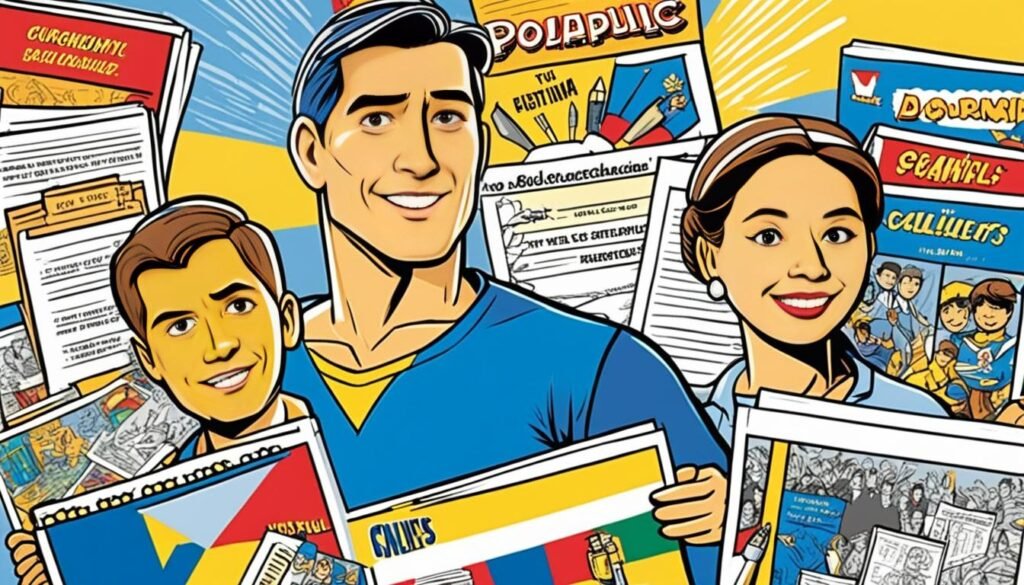
Social Issues
The start of the First Philippine Republic marked a time filled with poverty and economic hardship. People struggled to access healthcare. There was also big gender inequality issue. Most lived poorly, finding it hard to meet basic needs. The healthcare system was weak, leaving many without medical help.
Poverty and Economic Hardship
Reports show that most folks in the Republic were poor. They had few resources or chances for better lives. This led to even bigger gaps between the rich and the poor. The wealthy had a lot more power over everyone else.
Healthcare Challenges
The healthcare setup in the Republic was far from good. It left many without even the basics in medical care. Because of this, many had health issues. The most in need were often left behind.
Gender Inequality
During this time, women in the Republic were held back by society and the law. Their freedom and role in public life were heavily restricted. This gender inequality kept women from having equal chances. It also supported a society that put men first then others.
Political Instability and Governance Issues
The First Philippine Republic had a tough time making a strong government. It shifted from a revolutionary to a constitutional state. This change brought a lot of political instability and governance issues. The Malolos Congress, in charge of making the constitution, faced many hurdles. Their work didn’t help much with the instability of the young nation.
Challenges of Establishing a New Government
Getting used to a constitutional republic was hard for the First Philippine Republic. The Malolos Congress found it hard to form a solid government. They had to think about what the nationalist group wanted and the real issues of the day. This was tough because everyone within the government wanted different things.
Internal Conflicts and Power Struggles
In the First Philippine Republic, there were many fights for power. This made it hard to agree on plans or solve big social problems. The Platform for Action, Commitments and Transformation (PACT) says it’s key to get everyone involved in decisions to avoid or stop such fights. But this was a lesson the First Philippine Republic didn’t learn well during its short time.
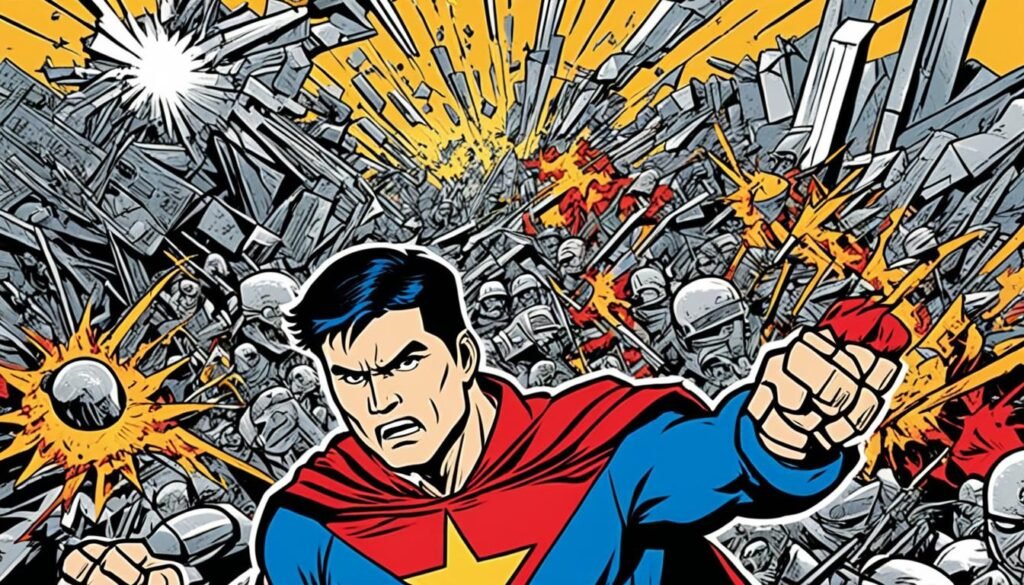
Religious Tensions and the Church-State Relationship
The fight between the church and state was a big deal when the First Philippine Republic was starting. At the Malolos Congress, they talked about if Catholicism should be the main religion. They also discussed if it was better to keep religious tensions apart from church-state relationships. The congress decided to keep them separated. This decision showed the republic wanted freedom of religion and a true democracy.
Recently, President Duterte and the Catholic Church haven’t been getting along. Their clashes are unusual and have merged religious and political lines. This mix-up has influenced important topics, like the war on drugs and human rights abuses.
“Church and State” is usually used for the link between religious groups and the government. But, globalization has made us question this name. It might seem unfair to non-Christian religions. Some people think “Religion and State” is a better term to include all faiths.
The relationship between religion and the state is a big subject in many fields like political science and law. For many countries, becoming more secular has brought new tests. They now deal with making moral laws without being tied to one faith. For example, discussions on topics like abortion and euthanasia are common. In places like the US, there are arguments against using religion to make laws.
In Europe, discussions on laicity and Islam are ongoing, especially on issues like burqas and headscarves. The European Union deals with religion in a unique way. They make sure to treat all religions fairly, without showing one as special. The main goal is to have a state that doesn’t promote any religion. This way, people can believe as they want.
The relationships between church and state in Western Europe are complicated. In Northern Europe, some countries have state churches. But places like Ireland are secular yet mostly Catholic. These variations affect the region’s politics and society. They also add to global conversations about the right place of faith in public life.
Impact of the Philippine-American War
In 1899, the Philippine-American War began, only months after the First Philippine Republic formed. This war changed the country a lot. It caused a lot of fighting, making many people leave their homes or lose them, and communities were damaged.
Disruption of Daily Life and Social Fabric
Life changed horribly for the Filipino people during the Philippine-American War. Many had to leave their homes because of the fighting. This led to lots of homes and communities being destroyed, leaving people without a place to live or their basic needs.
Friends and families were separated by the violence and chaos. This made their social bonds and culture weaker. The war’s hardships and trauma made everyday life very hard for everyone.
Economic Consequences
The young republic’s economy got hit hard by the war, too. Farmers couldn’t tend to their fields, either fleeing or getting caught up in the battles. This meant not enough food was grown.
Trade also suffered a lot. Roads and other ways to move goods were broken or blocked by the war. Trying to keep the economy running was very tough, making life harder for the country’s people.
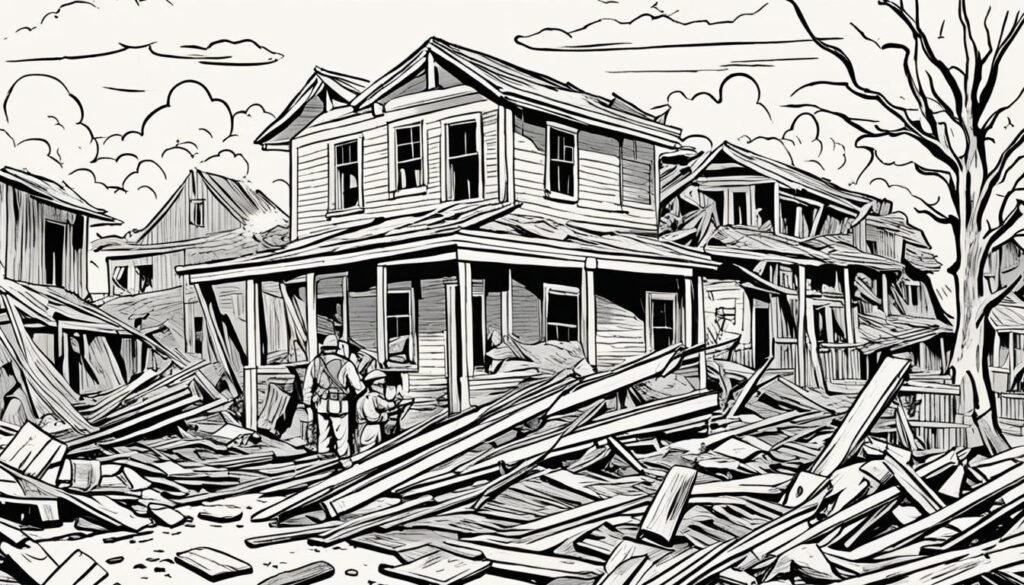
Efforts to Address Social Issues
The Malolos Congress knew the First Philippine Republic was struggling with many social issues. They decided to do something about it. This congress started reforms, like opening the Universidad Literatura de Filipinas. This university and other schools aimed to help more people get an education.
Reforms Initiated by the Malolos Congress
The Malolos Congress was key in starting efforts to fix social issues in the First Philippine Republic. One highlight was setting up the Universidad Literatura de Filipinas to educate Filipinos. They also helped start other schools to raise literacy rates and offer more people an education.
Role of Civic Organizations and Activists
Beside the Malolos Congress, civic organizations and activists were vital. They fought for social reforms and against unfairness. They worked hard to highlight tough social issues like unequal classes, poor health access, and gender bias. Despite facing challenges from the republic’s short life and conflicts, their groundwork helped future social movements in the Philippines.
Legacy and Influence on Modern Philippine Society
The First Philippine Republic was brief but its impact is deep. It introduced key legacy elements still in use today. These include democracy, a government by representatives, and keeping church and state separate. The ideals highlighted in the Malolos Constitution affect the country’s laws and customs today. Their fight to become independent and address social problems inspires many Filipinos striving for fairness.
This republic left a mark through its emphasis on democracy and tackling tough social issues. It pushed for school for everyone, health care, and equal rights. Their work influences today’s attempts to make society better. Their choice to separate religious and government matters strengthened the government and keeps religious freedom safe.
Its influence on today’s society also includes a strong national feeling and culture pride. The struggle for freedom, led by heroes like Emilio Aguinaldo and José Rizal, is now part of the national story. They inspire many to work towards a more fair and equitable future.
The legacy and influence of the First Philippine Republic are strong in today’s life. They continue shaping politics, society, and culture. Their morals for unity and growth are still used in facing current challenges. This republic’s impact remains alive and meaningful.
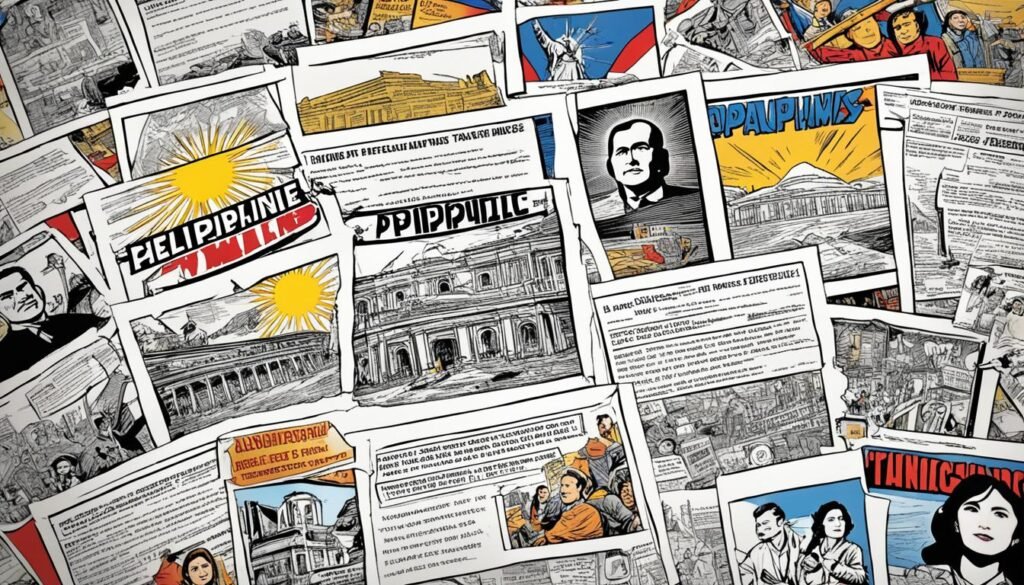
Lessons Learned from the First Philippine Republic
The First Philippine Republic teaches us important things. It shows how hard it is to make a new country work well. This new government faced problems like rich and poor not being equal, not everyone getting to go to school, and fights with other countries.
These issues are still issues today. The Philippines uses what it learned from its first republic to make the country better for everyone. It works to be a place where everyone can succeed. Leaders focus on making sure the government is stable and fair. They also work on making sure all people can get a good education.
The First Philippine Republic was important because it tried new ways of governing. Even though it didn’t last long, its ideas are still around. The country still follows things like having a government that represents its people and keeping religion separate from politics.
These ideas show us we can always improve. By looking at the past, the Philippines finds ways to solve today’s problems. It uses the successes and mistakes of the First Philippine Republic to get better and stronger.
Comparative Analysis with Other Historical Republics
The First Philippine Republic stands out as Asia’s first constitutional republic. It faced similar challenges like many other new republics. These included finding a balance between their nationalism dreams and the division within society. They also struggled with deciding the level of power each part of the country should have and seeking global recognition and help. Looking at how the First Philippine Republic dealt with these issues gives us lessons on building a nation and transitioning to democracy.
Comparative historical analysis is key in the field of social sciences and history, especially in understanding global politics. It looks at the ways different republics tackle similar challenges. Within this field are three main areas of study: ways institutions are set up, how people make decisions, and the roles of culture. Reflecting the First Philippine Republic within this vast discussion helps us see the big picture. It shows us the parallels, differences, and lasting influences on the Philippines today.
Just like similar republics in history, the First Philippine Republic faced its own set of tests. These included their dreams for the country, dealing with divisions, and deciding how much power the central government should have. By exploring these situations alongside other historical examples. We can understand the challenges of building a nation and striving for a stable democracy. These insights are vital for anyone interested in the Philippines’ development.
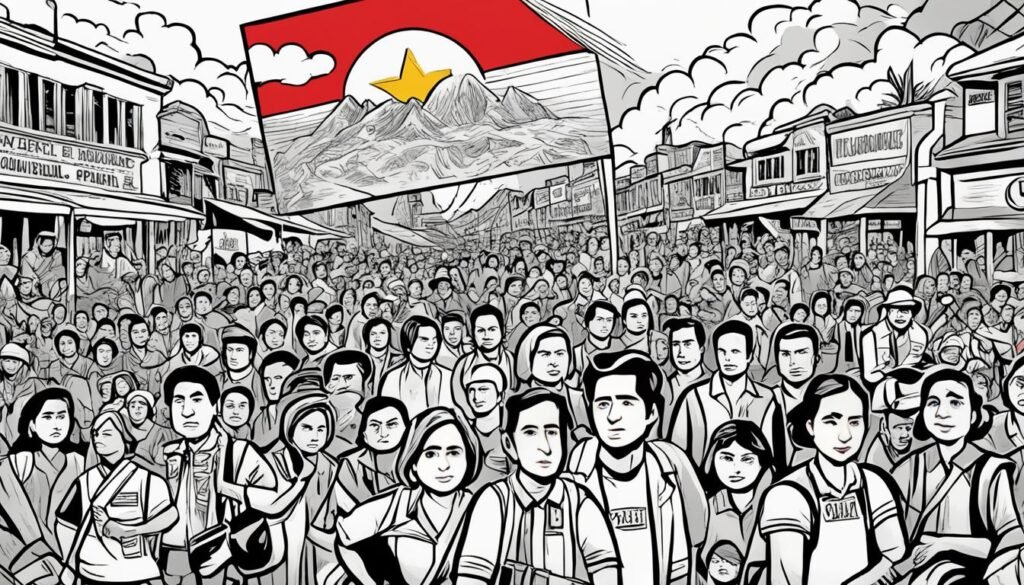
Challenges in Addressing Social Issues Today
Many social issues from the past still affect the Philippines today. Poverty and income inequality are big problems. A lot of people struggle to make a living and don’t have enough money.
Access to quality education and healthcare is also hard for many. There are big differences in education and health care between rich and poor areas. The challenges now show how serious these issues are yet to be solved.
Poverty and Income Inequality
Poverty and income inequality are major problems in the Philippines. Even with economic growth, many Filipinos can’t meet their basic needs. This divide between rich and poor keeps growing, making life harder for those at the bottom.
Access to Education and Healthcare
Making access to education and healthcare fair is tough in the Philippines. Although progress has been made, there are still big differences in teaching quality and school access. The healthcare system also has issues like being too expensive or hard to reach for some, which makes it difficult to get quality healthcare services.
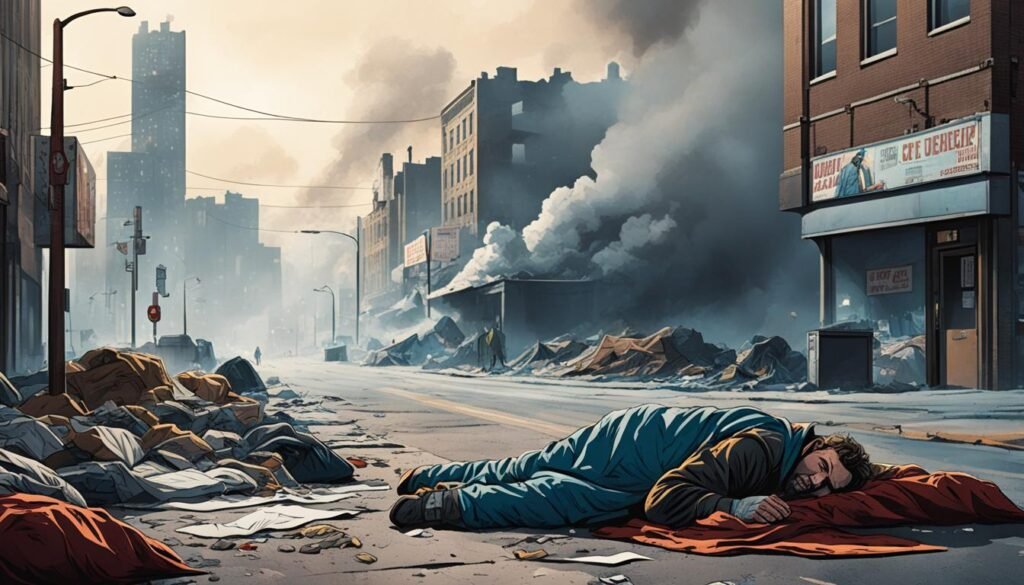
| Social Issue | Prevalence in the Philippines | Potential Impact |
|---|---|---|
| Poverty | Poverty rate of 16.6% in 2018, with 17.6 million Filipinos living below the poverty line | Limits access to basic necessities, education, and healthcare, exacerbating inequality and social instability |
| Income Inequality | Gini coefficient of 0.448 in 2018, indicating a high level of income inequality | Concentration of wealth and power in the hands of a few, hindering social mobility and economic opportunities for the majority |
| Access to Education | Net enrollment rate of 94.2% in primary education and 69.1% in secondary education in 2019 | Barriers to education perpetuate the cycle of poverty and limit social and economic advancement |
| Access to Healthcare | Out-of-pocket health expenditure as a percentage of total health expenditure was 53.9% in 2019 | Limited access to affordable and quality healthcare services compromises the overall health and well-being of the population |
Conclusion
The First Philippine Republic faced key social issues that are still familiar today. These included inequality, lack of education for everyone, poverty, and health problems. Politically, the country was also quite unstable. The struggles of the Malolos Congress were often hindered by the short life of the republic and the war with the Americans.
The First Philippine Republic, though short-lived, made some lasting impacts. It championed democracy and the idea that church and state should be separate. This has deeply influenced the country’s political and social growth. Learning from its experiences and teachings can help to solve the present day social problems in the Philippines.
As the Philippines moves forward, the lessons from the First Philippine Republic are vital. They remind us of the difficulties in building a nation and making social change. By respecting and learning from history, the nation can steer towards a better, fairer future.
FAQ
What were the key social issues faced by the First Philippine Republic?
The First Philippine Republic faced big issues. These included class inequality, lack of universal education, and more. Poverty and the war with the U.S. added to its challenges.
When was the First Philippine Republic established and how long did it last?
The First Philippine Republic, known as the Malolos Republic, began in 1899. It came after the Philippines fought against Spain and then the U.S. It lasted till 1901 when it joined the United States.
How did class inequality and elitism affect the First Philippine Republic?
The First Philippine Republic had deep class divisions. The rich and educated held most power. The poor had very few chances to improve their lives.
What was the state of education in the First Philippine Republic?
The Republic had very few schools. This kept many Filipinos from getting an education. Not many people could read or write.
What other social issues did the First Philippine Republic grapple with?
Poverty and gender inequality were major problems. Most people lived with very little. Women also had few rights and were held back.
How did the political instability and governance issues affect the First Philippine Republic?
The Republic had trouble building a strong government. There were many fights for power. This made governing very hard.
What was the relationship between the church and the state in the First Philippine Republic?
The Church and State debated their roles in the Republic. They decided on a separation, allowing for religious freedom. This choice helped the country move towards a democratic system.
How did the Philippine-American War impact the First Philippine Republic?
The war against the U.S. was devastating. It disrupted daily life and caused much damage. This took a big toll on the country’s economy and progress.
What efforts were made to address the social issues in the First Philippine Republic?
The Malolos Congress tried to fix many problems. It set up schools to help with education. Other groups also worked hard for change.
What is the legacy and influence of the First Philippine Republic on modern Philippine society?
The Republic’s fight for freedom and social justice has inspired the country. Its democratic ideals still shape the Philippines today. It showed the importance of a fair society.
What lessons can be learned from the experience of the First Philippine Republic?
The Republic’s history teaches us much about building a new nation. It shows the challenges in fixing social issues. Its story still guides the Philippines in creating a better future.
How does the First Philippine Republic compare to other historical republics?
Compared to other republics, the First Philippine Republic faced similar challenges. It needed to balance its independence dreams with the need for unity. It also deals with internal and external struggles like many others did.
How do the social issues faced by the First Philippine Republic continue to impact the Philippines today?
Many of the Republic’s social problems are still around. Poverty, lack of education, and healthcare are big issues. The country still works to overcome these challenges from its past.
Source Links
- https://en.wikipedia.org/wiki/First_Philippine_Republic
- https://medium.com/alpha-beta-blog/economic-surpluses-social-classes-and-inequality-3da27903db05
- https://www.humanium.org/en/right-to-education/
- https://www.britannica.com/topic/social-issue
- https://agendaforhumanity.org/transformation/46.html
- https://www.mdpi.com/2077-1444/10/3/197
- https://www.sciencedirect.com/topics/social-sciences/church-and-state
- https://history.state.gov/milestones/1899-1913/war
- https://www.thoughtco.com/philippine-american-war-4846100
- https://en.wikipedia.org/wiki/Social_issue
- https://www.ijams-bbp.net/wp-content/uploads/2022/04/IJAMS-MARCH-310-322.pdf
- https://scholarworks.wm.edu/cgi/viewcontent.cgi?article=4025&context=etd
- https://www.fwd.com.ph/blog/family-and-relationships/remembering-jose-rizal/
- https://www.nationalww2museum.org/war/articles/july-4-1946-philippines-independence
- https://www.cambridge.org/core/journals/perspectives-on-politics/article/comparative-historical-analysis/53A6AB1CD94F439C2CEC9A6DD9814504
- https://warwick.ac.uk/fac/soc/economics/seminars/seminars/conferences/conf/eloranta.pdf
- https://www.cambridge.org/core/journals/comparative-studies-in-society-and-history
- https://openoregon.pressbooks.pub/socproblems/chapter/1-6-conclusion/

